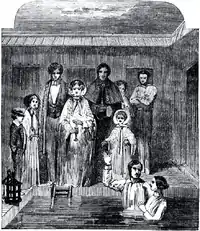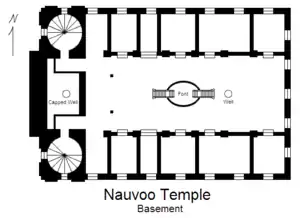Baptism in Mormonism
In the Latter Day Saint movement, baptism is recognized as the first of several ordinances (rituals) of the gospel.[1]
Overview

Much of the Latter Day Saint theology of baptism was established during the early Latter Day Saint movement founded by Joseph Smith. Baptism must be by immersion and is for the remission of sins (meaning that through baptism, past sins are forgiven), and occurs after one has shown faith and repentance. Latter Day Saint baptism does not purport to remit any sins other than personal ones, as adherents do not believe in original sin. Baptisms also occur only after an "age of accountability" which is defined as the age of eight years.[2] The theology thus rejects infant baptism.[3] According to the account in Joseph Smith–History 1:68,[4] the first Latter Day Saint baptisms occurred on May 15, 1829, when Joseph Smith and Oliver Cowdery baptized each other in the Susquehanna River near Harmony, Pennsylvania shortly after receiving the Aaronic priesthood from John the Baptist.
In addition, Latter Day Saint theology requires baptism only be performed by a priesthood holder.[5] The minimum required priesthood level to perform a baptism in Mormonism is priest, who is a worthy male members at least 15 years old,[6] and the rite is overseen by a bishop. Because the churches of the Latter Day Saint movement operate under a lay priesthood, children raised in a Mormon family are usually baptized by a father or close male friend or family member.
Latter Day Saints view baptism as symbolic of Jesus' death, burial and resurrection,[7] and also symbolic of the baptized individual separating from the "natural" or sinful aspects of humanity and becoming spiritually reborn as a disciple of Jesus.

Membership into a Latter Day Saint church is granted only by baptism. Most Latter Day Saint churches do not recognize the baptisms of other faiths as they believe baptisms must be performed under the church's unique priesthood authority. Therefore, any converts are baptized at their conversion.
Baptism (and any subsequent callings in the church) are preceded by a baptismal interview.[8]
Procedures
Section 20 of the Doctrine and Covenants first documented the instructions for Latter Day Saint baptism.
"The person who is called of God and has authority from Jesus Christ to baptize, shall go down into the water with the person who has presented himself or herself for baptism, and shall say, calling him or her by name: Having been commissioned of Jesus Christ, I baptize you in the name of the Father, and of the Son, and of the Holy Ghost. Amen. Then shall he immerse him or her in the water, and come forth again out of the water."[9]
People being baptized or performing the baptism typically wear a "one-piece suit" with "short sleeves, and is lined to the knee." Baptisms are usually performed in a baptismal font, but any body of water in which the person may be completely immersed is acceptable. The person administering the baptism must recite the prayer exactly, and immerse every part, limb, hair and clothing of the person being baptized. If there are any mistakes, or if any part of the person being baptized is not fully immersed, the baptism is repeated until it is performed correctly. In addition to the baptizer, two church members witness the baptism to ensure that it is performed properly.[10][11][12]
Following baptism, Latter Day Saints receive the Gift of the Holy Ghost by the laying on of hands of a Melchizedek priesthood holder.[13]
Baptism for the dead

The Church of Jesus Christ of Latter-day Saints (LDS Church) practices baptism for the dead "vicariously" or "by proxy" in their temples for anyone who did not receive these ordinances while living.[14]
Rebaptism
After the death of Joseph Smith, the founder of the Latter Day Saint movement, in 1844, rebaptism became a more important ordinance in the LDS Church, as led by Brigham Young. Young led his group to the Great Basin in what is now Utah, and most of his followers were rebaptised soon after arriving as a sign that they would rededicate their lives to Christ. During the "Mormon Reformation" of 1856–57, rebaptism became an extremely important ordinance, signifying that the church member confessed their sins and would live a life of a Latter-day Saint. Church members were rebaptized prior to new covenants and ordinances, such as ordination to a new office of the priesthood, receiving temple ordinances, getting married, or entering plural marriage. In an 1881 letter from apostle Joseph F. Smith, he states, "Will you please notify the Bishops in your Stake that all persons whose first baptisms have not taken place within a very recent period must be re-baptized before they receive their recommends to pass through the House of the Lord."[15]
In addition to acting as a sign of repentance and recommitment, rebaptism was also seen as a healing ordinance frequently practiced in the temple as such until around 1922 when the First Presidency issued a letter stating that "baptizing for health is no part of temple work, and therefore to permit it to become a practice would be an innovation, detrimental to temple work, and a departure as well from the practice instituted of the Lord for the care and healing of the sick."[16]
Rebaptism remains a practice in the LDS Church today, but is practiced only when a previously excommunicated member rejoins the church. In such cases, the wording of the ordinance is identical to that of the first baptismal ordinance.
References
- Porter, Bruce D. (October 2000). "The First Principles and Ordinances of the Gospel". Ensign. Retrieved March 24, 2009.
- "Account, Accountable, Accountability", The Guide to the Scriptures, LDS Church
- "Infant Baptism", The Guide to the Scriptures, LDS Church
- Joseph Smith–History 1:68
- See, e.g., Guide to the Scriptures: Baptism, Baptize, §Proper authority.
- See, e.g., Gospel Topics: Priest, churchofjesuschrist.org.
- See, e.g., Bible Dictionary: Baptism, ¶2.
- The Church of Jesus Christ of Latter-day Saints
- Doctrine and Covenants 20:73–74.
- Duties and Blessings of the Priesthood: Basic Manual for Priesthood Holders, Part B: Performing Priesthood Ordinances, §Baptism.
- "Handbook 2: Administering the Church". ChurchofJesusChrist.org. United States of America: Intellectual Reserve, Inc. 2010. pp. 170–173. Retrieved 2016-12-10.
- [https://newsroom.churchofjesuschrist.org/article/october-2019-general-conference-first-presidency-leadership-session%7Ctitle=General Conference Leadership Meetings Begin|access-date=2019-10-03
- Duties and Blessings of the Priesthood: Basic Manual for Priesthood Holders, Part B: Performing Priesthood Ordinances, §Confirmation.
- Baptisms for the Dead, churchofjesuschrist.org
- Devory Scott Anderson, "Development of LDS Temple Worship, 1846-2000: A Documentary History" Signature Books 2011
- Thomas G. Alexander "Mormonism in Transition" University of Illinois Press, 1986, pg 290-291